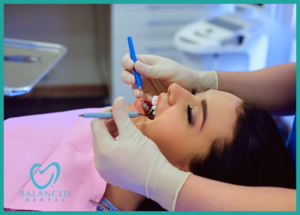Ever wonder if there’s a more natural way to approach dental care? Look no further than ozone dentistry! Discover how ozone dentistry can complement your current dental routine and explore a more holistic approach to a healthy smile. You can come in and meet Dr. Jackson and learn more about how Ozone works to activate the immune system, improve circulation, and eliminate pathogens. This gentle treatment encourages antioxidant use and oxygen metabolism in the body, thus killing bad bacteria and restoring your teeth and gums. Read on!
Medically Reviewed By Colgate Global Scientific Communications
Ozone dentistry is not what most people think of when they hear the word “ozone.” After all, ozone is the particular layer of our atmosphere that protects us from the sun’s ultraviolet rays. But the ozone molecule also has uses in dentistry.
According to a review in The Saudi Journal for Dental Research, the ozone molecule consists of three oxygen atoms bonded together to create a negatively charged particle that exists in nature as a colorless gas. In the 1930s, Dr. E.A. Fisch began using ozone in dentistry due to its strong antibacterial and wound healing properties. Today, it’s widely used in Europe and South America, according to an article in Interventional Neuroradiology (IN).

Ozone Uses in Dentistry
Dentists can apply ozone in the form of gas, water or oil, as the IN article explains. It has proven useful in treating a number of different dental issues:
- Tooth Decay: Preventing and managing tooth decay is one of your dentist’s primary concerns. According to an article in the Journal of the Formosan Medical Association (JFMA), ozone’s antibacterial properties may help prevent small cavities from growing larger in the pits and fissures on the biting surfaces of the back teeth. Additionally, ozone may be helpful in disinfecting areas of decay underneath tooth restorations.
- Periodontal Disease: According to a study in the International Journal of Health Sciences, periodontal (gum) disease is the most common oral condition in the world. It starts as an asymptomatic infection in the gums but, over time, can spread to the part of the jawbone that forms the sockets supporting the teeth. Ultimately, periodontal disease can result in the loss of the supporting bone and teeth in your mouth. The IN article notes that ozone has shown promise in helping disinfect areas of chronic gum infection. A dentist can apply it directly to the gums as a gas or in oils or water, allowing the ozone to infiltrate the collar of gum that surrounds each tooth and any abscesses.
- Endodontics: Endodontic procedures, including root canals, become necessary when the pulp tissue inside of a tooth becomes irreversibly infected. In past centuries, this condition often required the removal of the infected tooth, but today, root canal therapy is performed to remove only the infected tissues so that the natural tooth can remain and function normally in the mouth. As explained in the IN article, ozone may help disinfect the canal inside the tooth, as well as the tissues around the tip of the tooth root. This can help prevent the infection from spreading.
- TMJ Pain: The temporomandibular joint (TMJ) can sometimes be subject to a group of disorders referred to as temporomandibular disorders. As the Mayo Clinic explains, this condition can cause jaw pain and limit a person’s ability to chew comfortably or even open their mouth. However, a study in Medical Principles and Practice showed that injections of ozone helped relieve symptoms in patients experiencing TMJ pain, indicating yet another potential use for ozone therapy.
- Other Infections: As mentioned in the article in IN, ozone has also proven useful in treating other infections associated with the tissues in and around the mouth, including sinus infections and lesions caused by viruses and fungi.
Obstacles to Using Ozone Therapy
While ozone therapy may be a common treatment in dental offices in other countries, it’s used far less in the U.S. This may be due to conflicting evidence regarding the effectiveness of the treatment, as mentioned in the JFMA article. Additionally, an article in The Open Dentistry Journal notes that ozone itself can have toxic side effects if inhaled as a gas, potentially causing damage to the pulmonary system and other organs.
If you need treatment for a dental issue, you should always talk to your dentist to discuss the best options for your situation. While ozone dentistry may remain a sideline practice for now, after further research into its powerful antibacterial applications, it may become a star player in dentistry in the not-so-distant future.












